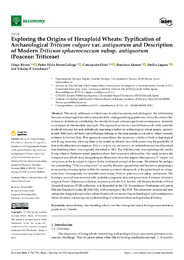Título :
Exploring the Origins of Hexaploid Wheats: Typification of Archaeological Triticum vulgare var. antiquorum and Description of Modern Triticum sphaerococcum subsp. antiquorum (Poaceae: Triticeae) |
Autor :
Rivera, Diego
Ferrer Gallego, Pedro Pablo
Obon, Concepcion 
Alcaraz, Francisco
Laguna, Emilio
Goncharov, Nikolay P. |
Editor :
MDPI |
Departamento:
Departamentos de la UMH::Biología Aplicada |
Fecha de publicación:
2024-11 |
URI :
https://hdl.handle.net/11000/38296 |
Resumen :
This study addresses a critical issue in plant taxonomy and phylogeny: the relationship
between archaeological materials and potentially analogous living populations. Given the current limitations
in definitively establishing the identity between archaeological and contemporary materials,
we propose an intermediate approach. This approach serves as a useful framework while scientific
methods advance towards definitively assessing whether an archaeological wheat sample, approximately
5000 years old from Central Europe, belongs to the same species as a modern wheat currently
endemic to Central Asia. This approach consolidates the taxonomic validity of both archaeological
and living materials, allowing them to be treated as distinct taxa while preserving the possibility of
future identification convergence. Triticum vulgare var. antiquorum, an archaeobotanical small-grained,
free-threshing wheat, was originally described in 1865. The 1982 discovery of morphologically similar
living wheat in Tajikistan raised questions about their taxonomic relationship. Our study reviews the
nomenclature of both taxa, designating an illustration from the original description of T. vulgare var.
antiquorum as the lectotype to align with the traditional concept of the name. We address the ambiguity
surrounding “Triticum antiquorum” as used by Russian agronomists and botanists, proposing a
more precise circumscription within the current systematic framework of the genus based on cytogenetic
data. Consequently, we describe a new taxon, Triticum sphaerococcum subsp. antiquorum. The
holotype, selected from material with available cytogenetic data and grown from Professor Udachin’s
original Pamir (Tajikistan) collection, is preserved in the N.I. Vavilov All-Russian Institute of Plant
Genetic Resources (WIR) collection. It is deposited at the I.M. Krasnoborov Herbarium of Central
Siberian Botanical Garden SB RAS (NS), with an isotype at the WIR. This taxonomic revision and new
subspecies designation provide a robust framework for reconciling archaeological and contemporary
wheat diversity, advancing our understanding of wheat evolution and agricultural history.
|
Palabras clave/Materias:
archaeobotany
free-threshing wheat
von Heer
hexaploid wheat
ectotype
nomenclature
ploidy level
Udachin |
Tipo de documento :
info:eu-repo/semantics/article |
Derechos de acceso:
info:eu-repo/semantics/openAccess
Attribution-NonCommercial-NoDerivatives 4.0 Internacional |
DOI :
https:// doi.org/10.3390/taxonomy4040042 |
Publicado en:
Taxonomy 2024, 4, 780–794. |
Aparece en las colecciones:
Artículos - Biología Aplicada
|
 La licencia se describe como: Atribución-NonComercial-NoDerivada 4.0 Internacional.
La licencia se describe como: Atribución-NonComercial-NoDerivada 4.0 Internacional.
.png)
